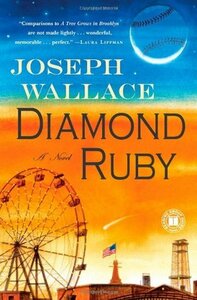Take a photo of a barcode or cover
i really enjoyed this book, and I appreciate that overall, Mr. Wallace seems to do his research and gives us some good information about times and issues while giving us a good story (I also enjoyed his other novel, Invasive Species). There was, however, one error that threw me out of the story so thoroughly that I couldn't go back to reading it for a half an hour -- on page 361, I read the following line: "He lived on the South Side, not far from Wrigley Field." Oh, the travesty! Any Chicagoans will be upset to read this, and I would think someone with a good knowledge of baseball would see this error right away, so perhaps this was an unintentional error, although I don't know how it got by the editors. I assume he meant Comiskey, rather than Wrigley, as it would make more sense, but it's also possible he accidentally wrote "South" when he meant "North." I just hate errors like this, because they make me skeptical of other information in the book (even though it's a novel, it's historical fiction, and when there are purported facts, they should be accurate.)
Otherwise, I liked this story, and I liked Ruby. There is a note wherein the author stated he was working on a sequel, and if he ever does finish it, I would read it.
Otherwise, I liked this story, and I liked Ruby. There is a note wherein the author stated he was working on a sequel, and if he ever does finish it, I would read it.
It happened to be right around the 4th of July that I picked this book up. I wanted to read something that optimized the American traditions, something that was truly patriotic, and I found that in Diamond Ruby. Ruby is a girl who has been thrown into the role of sole provider for her family after a tragic set of events. This 17 year old girl is now responsible for her alcoholic brother and his two young daughters in the tumultuous 1920's. This is a story of the strength of a woman who defied the times and the opinions of others to succeed in a man's sport- baseball. Ruby takes us from a small booth on Coney Island, to the house that Ruth built in her rise to fame. At first I thought that, though the story is enjoyable, the premise was a little far fetched, but I started googling around and found out that in fact, there was a 17 year old girl who struck out Babe Ruth and Lou Gehrig in an exhibition game in 1931. Ruby's story is loosely based around that historical incident. Pretty cool.
Loved this book. The plot was slightly convoluted but it was an interesting and engaging look at a time period I don't know much about. I like stories that evoke an era and this one definitely does this. I'm looking forward to reading the follow up novel.
Joseph Wallace and I "met" via Twitter. He was talking about his novel Diamond Ruby and described it as a baseball novel set in the 1920s. From that description alone I was hooked and told him so. He was nice enough to arrange for me to receive a review copy.
The book begins on a happy note, a baseball game attended by Ruby and most of her family. After the game she realizes her long arms might be an asset for throwing the perfect pitch. There's just one problem, it isn't ladylike to play baseball.
Instead of taking the warm fuzzy path and showing Ruby coming of age and continuing to practice her pitching, Wallace turns to history and the influenza outbreak that swept through the world after the close of the Great War. Ruby loses most of her family, leaving her the head of house hold an in charge of her two young nieces because her brother is no longer the man he was.
So rather than Ruby becoming a pitching hero through a happy childhood, she does it out of desperation. Her chance to provide for her family comes at price of being a Coney Island side show. The progression from happy child full of day dreams to determined surviver seems real and plausible in Diamond Ruby.
In the final act of the book Wallace takes some poetic license with baseball history and writes things how he wished they had played out. The endnotes include an explanation of what he changed, what historical figures inspired him and why he made the changes that he did.
The book begins on a happy note, a baseball game attended by Ruby and most of her family. After the game she realizes her long arms might be an asset for throwing the perfect pitch. There's just one problem, it isn't ladylike to play baseball.
Instead of taking the warm fuzzy path and showing Ruby coming of age and continuing to practice her pitching, Wallace turns to history and the influenza outbreak that swept through the world after the close of the Great War. Ruby loses most of her family, leaving her the head of house hold an in charge of her two young nieces because her brother is no longer the man he was.
So rather than Ruby becoming a pitching hero through a happy childhood, she does it out of desperation. Her chance to provide for her family comes at price of being a Coney Island side show. The progression from happy child full of day dreams to determined surviver seems real and plausible in Diamond Ruby.
In the final act of the book Wallace takes some poetic license with baseball history and writes things how he wished they had played out. The endnotes include an explanation of what he changed, what historical figures inspired him and why he made the changes that he did.
Started out a little slow, but turned out to be a great read. Wish it was a true story. It was based a little on a real person, but is fictional. Fun book for baseball season! Completely clean read too.
This was an incredibly satisfying summer read. And i cried. several times.
A strong young heroine, a fascinating glimpse of the 1920s --- well worth the read.




